Enjoy this 1979 production by the US Army Infantry School.
Enjoy this 1979 production by the US Army Infantry School.
WEST POINT, N.Y. — On the precipice 240 miles above the earth, Jeff Williams was ready to enter into the void.
It was a feeling he’d become used to over the years; solid ground beneath your feet, nothing but empty air across the ledge.
But this time it was different.
This was no helicopter flying over the U.S. Military Academy’s Camp Buckner, where he had jumped countless times as a member of the West Point Parachute Team.
It was a step off the space shuttle for a seven-hour spacewalk to continue the process of constructing the International Space Station.

“The sensation of being outside the spacecraft, orbiting the earth every 90 minutes, controlling yourself with just fingertip control and seeing the earth below, that is why I call it the ultimate skydive,” Williams, a retired Army colonel, NASA astronaut and a member of USMA Class of 1980, said. “It is absolutely incredible.”
When he arrived at West Point from the dairy farm in Wisconsin where he was raised, a future that included flying on anything, let alone a rocket into space, wasn’t on Williams’ radar. His father had served in West Germany for a few years following World War II, but that was the extent of the military service in his family.
Williams learned about the academy through his father’s role as a high school guidance counselor and from the get go his plan wasn’t necessarily a lengthy Army career. Heck, he wasn’t even sure if he was going to stay at West Point for the full four years. His goal was simply to prove his friends wrong who had doubted he would last at the banks of the Hudson River.
“I remember having friends from my hometown and one said you won’t make it past the summer and Beast Barracks,” Williams said. “The other one said he probably won’t make it to Christmas. I was going to at least win their arguments and beat both of them.”
Then he learned to fly and any thoughts of leaving the academy were gone.
When he’d first entered the academy, Williams didn’t even know the Army had aircraft, but at the end of his plebe year in 1977 he found the West Point Parachute Team. At the same time, his cadet sponsor was the commander of the academy’s aviation detachment.

By leaving the ground and soaring through the air, he found the balance needed to be successful at West Point. His sponsor and the other members of the aviation detachment taught him about their experience flying in Vietnam and introduced him to all an Army aviator could do, while the parachute team brought him friends and adventure.
First, the members of the team learned to jump via static line. Then they did “hop and pops” where you jump out and immediately pull your parachute. Finally, they started adding freefall time, first 10 seconds, then 20, then 30.
In those days, during the afternoon the members of the team would jump into Camp Buckner, whereas nowadays the team spends its afternoons after class jumping onto The Plain at the center of the academy. On weekends, they would travel out to Walkill to an abandoned airfield and jump all day. Go up, jump, land, fold up your parachute and go again six or seven times in a single day.
Jump after jump, Williams came to love the thrill and the intricacies of learning how to use and trust the parachute system. After not even knowing the Army had aircraft, he quickly set his sights on becoming a pilot following graduation.
It was also during those years when Williams first considered the idea of being not just an Army pilot, but an astronaut. During his cow year at the academy, Gen. Bob Stewart was selected to become a NASA astronaut making him the first active duty Army officer selected by NASA. A visit by Stewart to West Point, time spent with future astronaut Jim Adamson, who was teaching at West Point at the time, and reading “The Right Stuff” by Tom Wolfe opened Williams’ eyes to the possibility of space flight, much as joining the parachute team had first peaked his interest in being a pilot.
Following graduation, Williams’ first duty assignment was Germany, just as it had been for his dad years before. He learned to fly OH-58s and Hueys, but the astronaut program was never far from his mind. He applied for the first time in 1985 and would go on to apply five more times over 10 years before being selected as a member of the astronaut class of 1996.
“It is a good lesson I try to communicate to folks,” Williams said of applying six times and interviewing three. “One, to persevere with your goals and two, don’t take the disappointments personally because they’re usually not personal.”
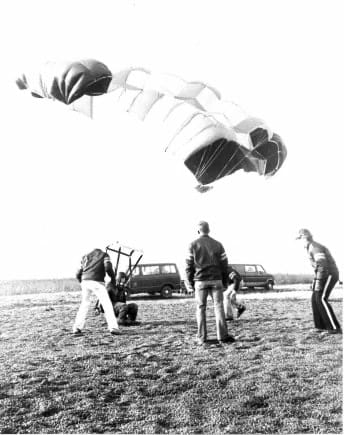
He launched for the first time on May 19, 2000 aboard the space shuttle Atlantis for a 10-day mission to work on constructing the International Space Station. He’d launch again in 2006, 2009 and 2016, each time aboard a Russian Soyuz rocket for a six-month mission seeing the ISS go from just started to fully operational across his four trips.
He spent nearly 32 hours outside performing spacewalks during his trips. It is in those experiences where his time spent training with the parachute team really came full circle to help him succeed.
Hanging by nothing but his fingertips, Williams would move around by “walking,” but it was really a hand over hand crawl through the void of space. The ability to control his body, move through the air and deal with important tasks while in a risky environment were all skills he had first learned a few thousand feet above Camp Buckner, but he was now using a couple hundred miles above earth.
“In some ways there are parallels between going out and being completely free of touching things in a skydive and controlling your body, the aerodynamics of your body by moving your arms and legs around and managing the risks and the challenges of doing a spacewalk,” Williams said.
Williams is still flight ready and on the astronaut roster, but his days of launching into space have likely come and gone following 534 days in space. The pathway from the West Point Parachute Team to the International Space Station continues, though.
Their paths to NASA were different, but as members of the parachute team, Col. Drew Morgan and Lt. Col. Frank Rubio, both in USMA Class of 1998, learned to fly together. The two made their first jumps on the same day, and although their Army careers took them to different places their paths have at times run parallel with both attending medical school and now both serving NASA as astronauts.
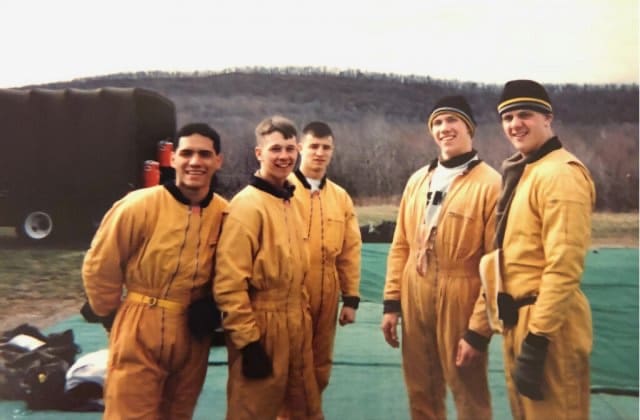
That connection started as plebes at the U.S. Military Academy when Morgan and Rubio found their way to the parachute team.
For Morgan, it was a continuation of a family legacy. Family stories of his great uncle Harry McClintock, a member of the 101st Airborne Division who jumped into Normandy on D-Day, had spurred his already budding interest in serving in the military and introduced him to the idea of becoming an Army paratrooper.
Rubio came to the academy for the education, unsure of what all was offered at West Point. He spent his first year playing what was then called 150s and is now Sprint Football but jumped at the opportunity to join the parachute team once he heard about it.
There, he found his best friends. The team demanded he give up time during the summer and over breaks, but it was worth it to take to the skies with teammates, including Morgan, who quickly became more like brothers.
“What I learned the most from the team was a sense of responsibility. Ultimately, you are getting trained to be a jumpmaster very early on in your life,” Rubio said. “You quickly learn that it is a lot of fun, it is a really neat thing to do, but it is a lot of responsibility. It is something you’ve got to take pretty seriously.”
Morgan is currently orbiting earth aboard the International Space Station during his first mission to space. He was a member of the astronaut class of 2013 and launched to the space station in July to take part in Expedition 60 and 61.
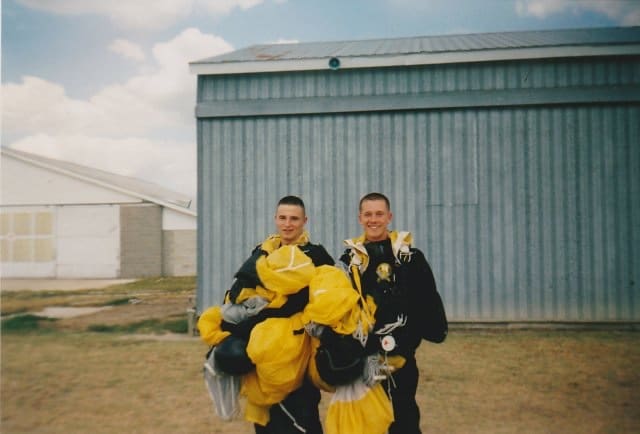
On Aug. 21, he followed in Williams’ footsteps and made the ultimate skydive into space for his first spacewalk.
“That camaraderie that we had (on the parachute team) and that dependency we had on each other, making sure that we were skilled in the aircraft and skilled in the air, our lives depended on each other to do safety checks of each other … I think about how 20 years ago, I was developing those skills at an early age and didn’t even know it,” Morgan said in a NASA interview.
While being an astronaut was always Morgan’s goal, it had only registered as a slight possibility to Rubio. That changed in 2017 with a phone call from his former parachute teammate. NASA was accepting a new class of astronauts and Morgan reached out to encourage him to apply.
“I was pursuing my own dreams at the time of being a special operations surgeon,” Rubio said. “When they took the next class and Drew gave me a quick call and said you may want to consider trying out I think you would be a good candidate, I began to think about it at length.”
Rubio was accepted as a member of the class of 2017 and began his two years of training as an astronaut candidate, which he will graduate from soon.

The training course teaches future astronauts how to fly a T-38 Talon, use the space suit, operate the robotics at the space station and how to operate the International Space Station. Due to NASA’s close relationship with the Russian Space Agency, astronaut candidates also have to learn Russian.
After graduation from astronaut candidate school, Rubio and his classmates will wait to be assigned missions, which typically takes a minimum of two years. After selection it is another two years of training before launching to the space station.
Williams was the first to make the leap from parachute team to astronaut, but Morgan and Rubio have followed along the same path and laid the groundwork for current and future team members to follow their own dreams to space.
With fall temperatures rolling in making the afternoons cooler and the sun setting over The Plain, the current members of the parachute team hone their skills much as their three predecessors did as cadets. Grab your parachute, fist pump the 2nd Aviation pilot, ascend to 3,000 feet, jump, land, fold up your parachute and do it all over again.
Jump after jump the team grows closer and their skills improve. How to control your body. How to trust your equipment. How to function in a high stress environment. All of it pays dividends no matter the career they choose to pursue in the Army, but as Williams and Morgan have shown and Rubio will soon learn, it also prepares you for the moment on the ledge with the earth spread out before your eyes as you prepare to make the ultimate skydive.
“To me that means I have a chance, honestly, which I think is super cool,” Class of 2021 Cadet Matthew Blejwas, a current member of the parachute team and aspiring astronaut, said. “Right now, just being able to follow in the footsteps of people that are making these great bounds for us as a society and as humanity is really humbling. I recognize that I’m in a spot where I have an incredible opportunity, and I don’t take that lightly.”
By Brandon OConnor
Everyday marks an anniversary of a significant event in American military history, but today stands out among them.
On this date in 1993, US service members were engaged in what is now known as the Battle of Mogadishu. Elements of TF Ranger, a joint organization, had deployed to Mogadishu, Somalia. Already having conducted operations for some time, on this day, they raided the city’s Olympic Hotel in order to capture key leaders of the Aidid Militia.
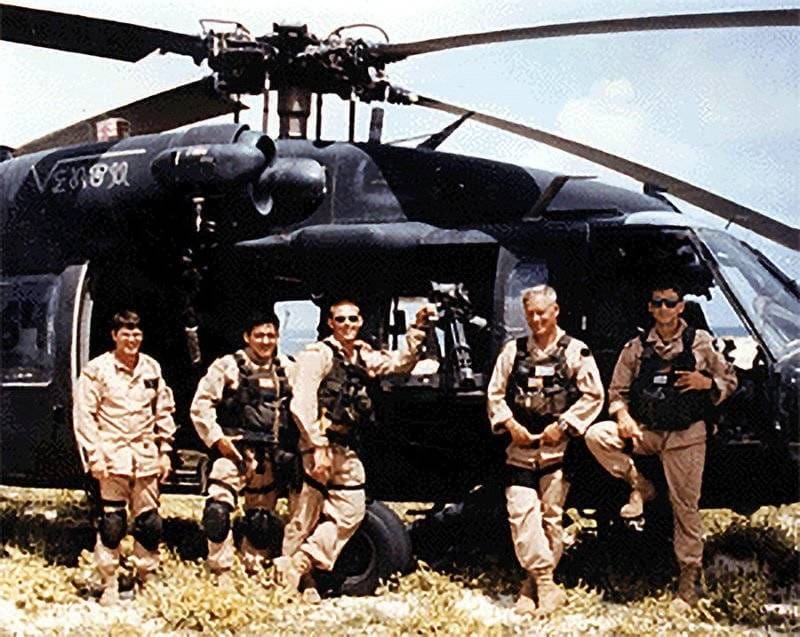
Unfortunately, during the exfil portion of the raid, a battle ensued which claimed the lives of 18 Americans and wounded another 73. Additionally, CW3 Michael Durant was captured by the Aideed militia. Fortunately, Durant was later repatriated and went on to retire from the 160th.
Of the men killed that day, two would be awarded the Medal of Honor, Delta Operators Gary Gordon and Randy Shughart, for their selfless efforts to protect Durant after his aircraft, callsign Super 64, was shot down.

If you are unfamiliar with the events, one of the best accounts of the battle is contained in the book, “Blackhawk Down” by author Mark Bowden. Much of the information was serialized prior to the book’s publication in the Philadelphia Enquirer. Later this was made into a movie bearing the same name.
Please take a moment to remember these men and their sacrifice.
Additionally, the 75th Ranger Regiment was created on this day in 1984, with the stand up of its 3rd Battalion. Thirty-five years later, the Ranger Regiment boasts boasts five battalions of some of the most elite warriors on the face of our planet.
Final Mission of a Valiant Workhorse
Fifteen days after the attacks of September 11th, 2001—on President George W. Bush’s orders—the Central Intelligence Agency (CIA) deployed a small team into Afghanistan’s Panjshir Valley. Its mission: to launch U.S. operations against al-Qaida and its Taliban supporters. JAWBREAKER, as the operation would be called, was the United States’ first response to those attacks, and stands as an exemplar of the extraordinary capacity of CIA and the broader U.S. Government to respond swiftly and decisively in defense of the country. The JAWBREAKER team of seven Agency officers, three aircrew and two Afghan partners boarded a Russian-made, CIA-modified, Mi-17 heavy-duty helicopter on what would become a historic flight.

The Search for 10,000 Pieces
Robert Byer, CIA Museum director and curator, opened the ceremony by thanking attendees for joining CIA in celebrating what he described as an “incredibly auspicious day that has been many years in the making.” He briefly recounted the story of how the Mi-17 helicopter came to rest on CIA campus as a “macro-artifact” in CIA Museum’s growing collection. A macro-artifact, Mr. Byer explained, simply means that “we couldn’t fit it inside the building.”

“In 2006, CIA museum began working on an exhibition about the Agency’s role leading up to Operation Enduring Freedom,” Mr. Byer explained. What began as a small collection of photographs and artifacts from those involved in the early response to 9/11 quickly grew to include flight kits, cartography and even a cockpit instrument from the Mi-17. “The aircraft was ubiquitous in the part of the world,” he said. “Rugged and dependable and described by those who flew aboard as ’10,000 parts all trying to come apart at once,’” he explained to laughter from the audience.
In the fall of 2018, Mr. Byer and the rest of the CIA Museum staff reunited that single cockpit instrument with the remaining 9,999 pieces of the Mi-17 with its delivery to CIA campus. “With today’s dedication,” he said, “we now have the full story of CIA’s response to those attacks on American soil. It [the exhibition] serves as a bookend to its 911 counterpart,” Mr. Byer said referring to the 9,000 pound rust-colored steel column on the Southwest side of CIA’s Original Headquarters Building that was recovered from World Trade Center 6 in New York City.
Today—exactly 18 years after the members of operation JAWBREAKER set foot in Afghanistan—CIA had the distinct honor of commemorating that mission with the dedication of the Mi-17 that shuttled team JAWBREAKER over the “Hindu Kush and into history.” Adorned with the tail number 9-11-01, the fully-restored Mi-17 helicopter is nestled amongst the trees in a large green space to the northeast of CIA’s Original Headquarters Building. The rocky landscape on which the helicopter sits was designed to mimic the Afghan landscape in which the helicopter served so well. Hundreds gathered at CIA Headquarters in Langley, Virginia, to see the helicopter in its final home and hear from the Agency officers who played a significant role in the success of CIA’s first response.
To Right a Terrible Wrong
Mr. Byer welcomed Gina Haspel, Director of the Central Intelligence Agency, to the stage to introduce the ceremony’s keynote speaker, Gary Schroen, who delayed his retirement to lead Operation JAWBREAKER in 2001. “Today’s ceremony is a celebration of the daring spirit that defines the Central Intelligence Agency,” Director Haspel said. She explained the importance of teamwork in the pursuit of success. “Gary and his team were at the tip of the spear, and at every step of the way there was an Agency family, here at Headquarters and across the world, who had their back.”
Director Haspel spoke of the courage and motivation of the JAWBREAKER team in their pursuit to “right a terrible wrong.” Her hope for this helicopter is that it serves as a reminder of the sacrifices made in defense of freedom and that visitor’s “gain a deeper appreciation of what it takes to keep our country safe and free.”
Business as Usual
Director Haspel introduced Mr. Schroen, the ceremony’s keynote speaker, as “a living legend and inspiration to every CIA Officer” and thanked him for his 50 years of service to the CIA.

Mr. Schroen took the stage to generous applause, a clear indication of the respect and admiration he commanded from those in attendance. He thanked Director Haspel for her remarks before launching into his recollection of the time, the operation and the sequence of events that led to his team landing in Afghanistan just two weeks after the attacks on American soil. “It’s an awkward looking piece of machinery,” he began. “But don’t be fooled – the Russians built it for utility and service, rather than looks and style.” He described the helicopter as a workhorse “designed to take a punishment,” which was exactly what the CIA needed.
He recounted the shudder of the helicopter as it began its ascent over the 14,500-foot Anjuman Pass and into Panjshir for the first time—a recollection that would make even the most valiant palms a bit sweaty. “We were very heavy,” he admitted. Between the passengers, weapons, fuel, ammunition and all of the other equipment, the team was pushing the helicopter’s payload to its outer extremes. “It wasn’t ‘business as usual,’” Mr. Schroen recalled. “But looking around the compartment, you would think it was – no one was dwelling on the danger we were in.”
Echoing Director Haspel’s comments on teamwork, Mr. Schroen noted that the success of the team was not theirs alone, but that of the “heroic efforts that this organization [CIA] made in getting the JAWBREAKER team ready.” He pointed to a number of officers and offices across the Agency that were instrumental to navigating the many processes needed to get JAWBREAKER airborne. He also credited the foundation which had been laid years prior, namely the relationships built with the Northern Alliance in Afghanistan, which would help JAWBREAKER navigate the unfamiliar territory.
Mr. Schroen concluded by expressing a simple hope that “we can all on occasion take a look at old 9-11-01 sitting out here, and remember that the seemingly impossible is in fact achievable.”
I often think there are things I’ll never get to share on SSD and then the CIA publishes something like this.

Recipients of Chicago Athenaeum’s 2019 American Architecture Awards have just been announced. Winners will be recognized at an awards gala on October 10th and featured in the forthcoming New American Architecture (Metropolitan Arts Press Ltd).
Now in its 25th year, the American Architecture Awards are the highest public awards given in the United States by a non-commercial, non-trade affiliated, public arts, culture, and educational institution. They are also the centerpiece of The Chicago Athenaeum and European Centre’s efforts to identify and promote best practices in all types of architectural development, as well as recognize design excellence and the best and next contributions to innovative contemporary American architecture.
“For 25 years, the American Architecture Awards have presented stunning and meticulously- designed projects that demonstrate quality architecture in the service of clients, as well as the general public, no matter the scale of project,” states Christian Narkiewicz-Laine, Museum President, The Chicago Athenaeum. “This year’s winning projects are the buildings that are profoundly shaping American architecture in the 21st-Century. Today’s celebrated award; tomorrow’s landmark.”
The 2019 entries were reviewed and winners selected by a prestigious jury composed of Miami based architects, educators, and developers including Alejandro Gonzalez of Arquitectonica (ARQ), Carlos Rosso of The Related Group, Luis O. Revuelta of Revuelta Architecture, Peter J. Studl (former Chairman) of The Chicago Athenaeum, Paolo Trevisan of Pininfarina of America, and Sebastian Salvat of Fortune International Realty.
Among the winners of the 2019 American Architecture Awards is the conceptual design for the anticipated 57,500-square-foot, National Museum of Intelligence and Special Operations. The effort is spearheaded by the OSS Society and will be built just north of Dulles International Airport, about 30 miles west of Washington, DC. Designed by Fentress Architects, the envisioned museum plans to educate the American public about the importance of strategic intelligence and special operations to the preservation of freedom, honor Americans who have served at the “tip of the spear” and inspire future generations to serve their country.
Curt Fentress, Principal in Charge of Design at Fentress Architects said, “The concept of the museum’s landmark design was inspired by the spearhead, a symbol used by the intelligence and special operations communities since World War II. The spearhead shape will define the footprint of the museum, which will be visible from the flight path of Dulles International Airport.”

Symbol of the OSS revealed in site plan

Side view of walkway to events pavilion

Events space

“Tip of the Spear” Pavilion
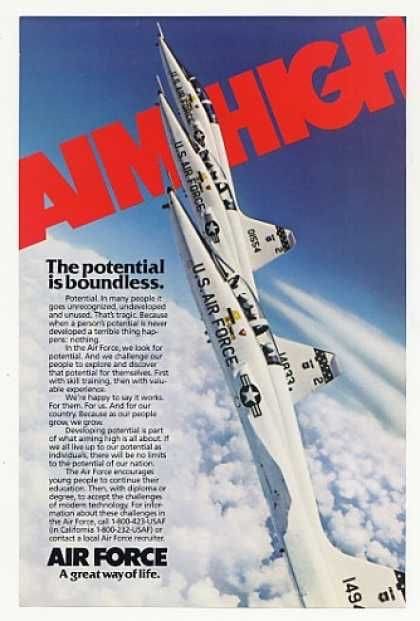
It’s been 72 glorious years!
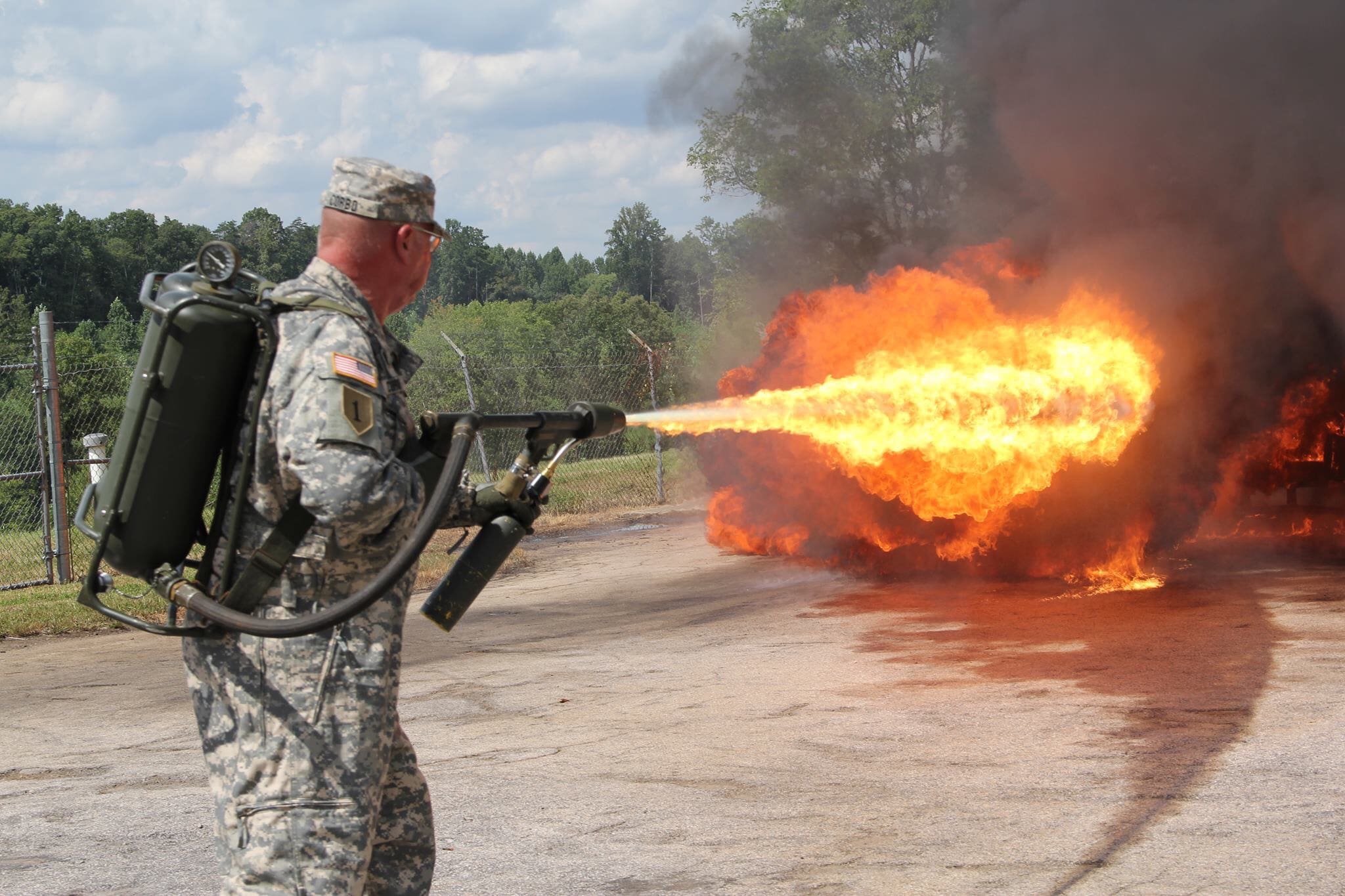
The AAF Tank Museum is hosting Flame Thrower Day.
There will be three demos, 11:30, 1:00 and 2:30, come rain or shine.
Their address is:
3401 U S Highway 29
Danville, Virginia 24540
It seems rather fitting to me that on this Labor Day I should share an Air Force heritage video on its maintainers.
Here’s to my Father, Father-in-law, Mother-in-law and Son, along with all of those other AF Maintainers past and present who kept our planes flying so this noner could jump out of them.